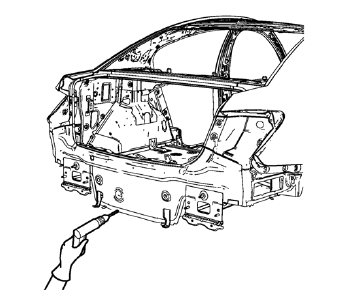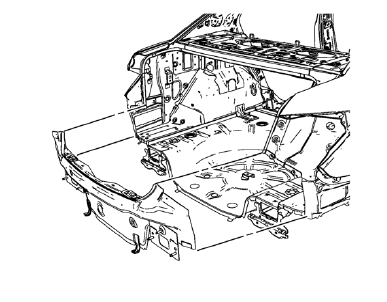Chevrolet Cruze Repair Manual: Removal Procedure
Warning: Refer to Approved Equipment for Collision Repair Warning in the Preface section.
Warning: Refer to Glass and Sheet Metal Handling Warning in the Preface section.
- Disable the SIR System. Refer to SIR Disabling and Enabling.
- Disconnect the negative battery cable. Refer to Battery Negative Cable Disconnection and Connection.
- Remove all related panels and components.
- Visually inspect the damage. Repair as much of the damage as possible.
- Remove the sealers and anti-corrosion materials from the repair area, as necessary. Refer to Anti-Corrosion Treatment and Repair.

- Locate and mark all the necessary factory welds of the body rear end panel.
Note: Note the number and location of welds for installation of the service assembly.
- Drill all factory welds.

- Remove the body rear end panel.
 Body Rear End Panel Replacement (MIG-Brazing)
Body Rear End Panel Replacement (MIG-Brazing)
Note: According to different corrosion warranties, only the
regional mandatory joining methods are allowed. ...
 Installation Procedure
Installation Procedure
Clean and prepare the attaching surfaces for welding.
Apply structural adhesive to the attaching surfaces.
Position the body rear end panel on the vehicle.
Verify the fit of the body ...
Other materials:
Front Side Door Window Regulator Motor Replacement
Preliminary Procedure
Remove the front side door window regulator. Refer to Front Side Door Window
Regulator Replacement.
Front Side Door Window Regulator Motor Screw (Qty: 3)
Caution: Refer to Fastener Caution in the Preface section.
Tighten
9 N·m (80 lb in)
Front Side Door Wind ...
Visual Aiming Preparation Procedure
Important: Some state and local laws specify requirements for
headlamp aim. Comply with all of these laws when performing any
headlamp aiming operations.
Headlamp aim should be checked:
When a new headlamp capsule is installed.
If service or repairs to the front end area have, or may have, ...
Installation Procedure
Install the following components on the drivetrain and front suspension
frame:
CH 49460-1 adapter (2).
CH 49460-2 adapter (4).
CH 6615-10 hydraulic cylinder (1).
NEW frame insulator (3)
Note: Check marking of frame insulator.
Press carefully the frame insulator in to the ...
